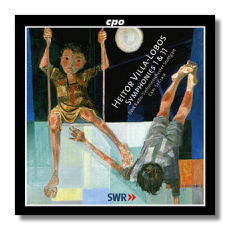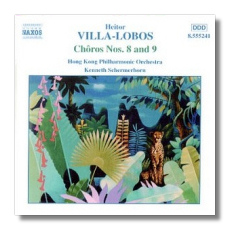
The Internet's Premier Classical Music Source
Related Links
- Villa-Lôbos Reviews
- Latest Reviews
- More Reviews
-
By Composer
-
Collections
DVD & Blu-ray
Books
Concert Reviews
Articles/Interviews
Software
Audio
Search Amazon
Recommended Links
Site News
 CD Review
CD Review
Heitor Villa-Lôbos

Symphonies
- Symphony #1 "The Unexpected" Op. 112
- Symphony #11
SWR Radio-Sinfonieorchester Stuttgart/Carl St. Clair
CPO 999568-2


- Symphony #6 "On the Outline of the Mountains of Brazil"
- Symphony #8
- Quinteto duplo de cordas (Suite pour cordes), for double string quintet
SWR Radio-Sinfonieorchester Stuttgart/Carl St. Clair
CPO 999517-2


- Chôro #8 for 2 Pianos & Orchestra
- Chôro #9 for Orchestra
Hong Kong Philharmonic Orchestra/Kenneth Schermerhorn
Naxos 8.555241
While Villa-Lôbos is rightly considered Brazil's greatest composer and has been recognized as one of the most important figures in 20th-century composition, he has not always fared well on recordings. His symphonies have been generally been neglected, and relatively few of his other works have received a significant amount of attention. True, some of the Chôros and Bachianas Brasileiras have garnered attention, as well as some of his piano and guitar works. But, despite his immense talent, he cannot not hold a candle to Prokofieff or Shostakovich, or to Stravinsky or even Hindemith, in popularity.
Why? Villa-Lôbos was one of those composers whose eclectic style made him extremely difficult to pin down, or even to recognize. Sometimes his music sounds Latin, sometimes European or American, and sometimes cosmopolitan, or a mixture of all these. Take the Symphony #6, for example. It starts off with a theme that could have been written by David Diamond. Certainly its orchestration – and the music's general vigor – are very much in the mold of Diamond. But could Villa-Lôbos have been familiar with the music of this then-young American composer? More importantly, would he have written music divulging such an influence? It is likely his kinship here with the style of Diamond is coincidental, part of his eclectic makeup. It was near the end of the war that Villa-Lôbos first visited the United States, around the time he composed this work. Diamond was just then freshly on the scene.
The rest of the symphony, too, divulges an American influence, as does the Eighth Symphony, though here it is generalized and more difficult to link to one or several composers. One can also notice hints of Hindemith in the work, particularly from his American period. This symphony is especially vigorous and optimistic, which must reflect the composer's confidence during a period when his international reputation was growing rapidly. Both the Sixth and Eighth Symphonies consist of four movements and have a twenty-five minute duration. Each has a Lento second movement, with the three other panels being mainly fast movements. Both symphonies are finely-wrought compositions, fully deserving rediscovery.
The early Suite pour Cordes (1912-13) is a lovely string orchestra version of a chamber work originally entitled Suite for Double String Quintet. Thematically the work is strongly appealing in its sentimental, quasi-Tchaikovskian manner.
The other CPO disc contains the First and Eleventh Symphonies, both of which time out to a few seconds over twenty-six minutes, both within a half-minute of the Sixth and Eighth! Again, only the second movements feature slow tempos here, but there is a world of difference between the relatively youthful First and the mature Eleventh. The latter work is just as optimistic, but exhibits an American sound, where the former has a vague French air hovering above its notes. The later Symphony also has a surer sense of orchestration and color. The First, by the way, has a text which the composer wrote under a pseudonym in 1907 and appended to the score. It has virtually nothing to do with the Symphony and is quite dispensable in the performance and understanding of the work.
In all four symphonies and in the Suite Cordes, Carl St. Clair leads the Stuttgart group with an insightful sense, capturing vigorous performances that are never less than compelling. The sound is vivid and well-balanced.
On the Naxos disc of the Chôros 8 and 9 we hear an entirely different side of the composer. The "chôro" was a type of popular music in Brazil, and Villa-Lôbos adopted that term for fourteen of his works, for various instrumental and vocal combinations. Using this 'choro' style, Villa-Lôbos attempted to express a kind of fusion of various musical styles in these compositions.
Both #8 and 9 are for orchestra and reflect the driving rhythms and colorful character of Brazilian folk music. The former was written 1925, the latter in 1929. #9 exhibits a bit more European character than the earlier work, but both are clearly cut from the same exotic musical fabric, featuring brilliant orchestration, colorful percussion and a deft sense for sharp contrasts. Both are light and often playful, and neither contains a moment's note spinning. Moreover, they feature the kind of catchy music that will have strong appeal on first hearing. This may prove the most immediately attractive of the three discs here, despite its paltry timing of about forty-two minutes. This issue was first released on Marco Polo in 1985 (or perhaps on what was then called Hong Kong Records), but its sound is excellent, fully competitive with most discs today. Kenneth Schermerhorn draws fine playing from the Hong Kong Philharmonic Orchestra, and while this ensemble may not have the tonal finesse and virtuoso technique of a world-class orchestra, their grasp of the choro style is fully convincing.
Copyright © 2002, Robert Cummings



















